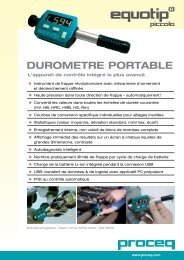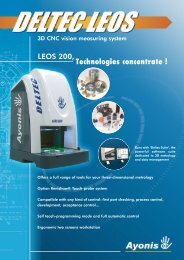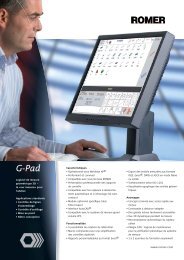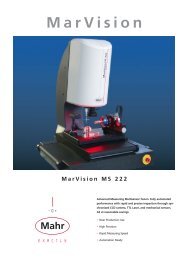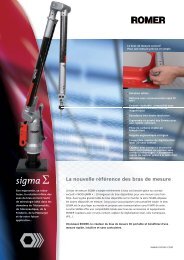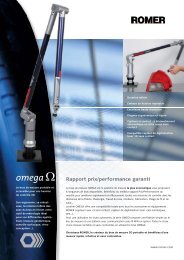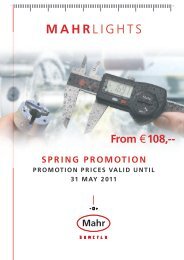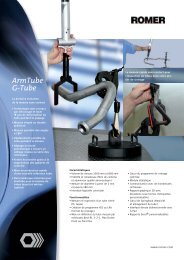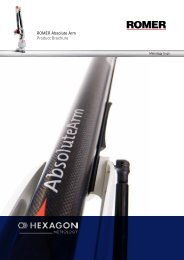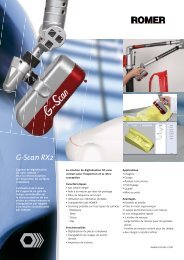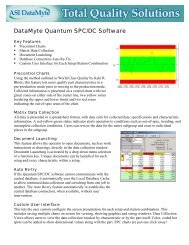Portable Hardness tester - EMS: European Metrology Systems sa
Portable Hardness tester - EMS: European Metrology Systems sa
Portable Hardness tester - EMS: European Metrology Systems sa
Create successful ePaper yourself
Turn your PDF publications into a flip-book with our unique Google optimized e-Paper software.
<strong>Portable</strong><br />
<strong>Hardness</strong> Tester<br />
The most advanced integrated <strong>tester</strong><br />
Revolutionary impact device with single motion load & release mechanism<br />
Highly accurate in any impact direction - automatically!<br />
Converts to all common hardness scales (HV, HB, HRC, HRB, HS, Rm)<br />
Custom conversions for uncommon alloys<br />
Statistics (average, standard deviation, min/max, range)<br />
Internal, non volatile data storage of fully tagged readings<br />
Instant reading from large, high-contrast LCD,<br />
Intelligent self diagnostics<br />
Virtually unlimited impacts per battery charge cycle<br />
Smart recharging of built in Li-Ion batteries while USB connected<br />
USB: data and software transfer with ver<strong>sa</strong>tile PC application<br />
Ready for automatic testing<br />
Patents pending - Standardized according to ASTM A956 + DIN 50156<br />
A High Quality Swiss Product<br />
www.proceq.com
Application Range - Primary Industries<br />
• Good for all materials<br />
• Ideal for production level testing<br />
• Best suited for on-site testing of heavy, big or already installed parts<br />
• Handy for difficult to access or confined test locations<br />
• Automatic sensing and compen<strong>sa</strong>tion for impact direction<br />
• Excellent for material selection and acceptance tests<br />
• Easy to use and accurate on curved test surfaces (R > 10 mm)<br />
• Metal production & processing<br />
• Automotive & transportation<br />
• Machinery & power plants<br />
• Petro-chemical, refineries<br />
• Aerospace & shipyard<br />
• Metal constructions<br />
• Testing services & laboratories<br />
The EQUOTIP measuring principle<br />
The EQUOTIP measuring principle is physically a rather simple, dynamic hardness test. An impact body with a hard<br />
metal test tip is propelled by spring force against the surface of the test piece. Surface deformation takes place when<br />
the impact body hits the test surface, which will result in loss of kinetic energy. This energy loss is calculated by velocity<br />
measurements when the impact body is at a precise distance from the surface for both the impact and rebound phase<br />
of the test. The permanent magnet in the impact body generates an induction voltage in the single coil of the impact<br />
device (see signal below). The voltage of the signal is proportional to the velocity of the impact body, and signal<br />
processing by the electronics provides the hardness reading for display and storage.<br />
~v i<br />
v r<br />
HL =<br />
B<br />
* 1000 = * 1000<br />
A v i<br />
Time<br />
~v r<br />
The EQUOTIP hardness scale “HL”<br />
The hardness value HL was first introduced into measuring technology in 1975, when the method and the instrument<br />
were presented by its inventors Leeb and Brandestini (Swiss Patent 596550). The ratio between rebound velocity v r<br />
and impact veolocity v i multiplied by 1000 is taken to calculate the hardness value HL (HL = hardness in LEEB units).<br />
Method and instrument are named EQUOTIP derived from Energy QUOtient recalling the principle of energy measurement.<br />
The PICCOLO is the latest <strong>tester</strong> in the tradition of the EQUOTIP System.<br />
Hence, HL is a direct, standardized (ASTM A956) measurement of hardness. In contrast to static hardness testing,<br />
dynamic hardness test results contain additional information on reactive behavior of materials, e.g. on elastic<br />
properties of the material. Correlations to other hardness scales like Rockwell C (HRC) or Brinell (HB) are available<br />
and programmed as a standard feature in the PICCOLO. Converted values can be directly displayed on the large<br />
LCD. As conversions between different hardness scales are always material dependent and affected by some loss in<br />
accuracy, an extensive set of material specific conversions are available. With the PICCOLO the user can easily<br />
program his “company’s own” conversions for those alloys and materials not included in the standard list by using<br />
industry accepted empirical tests.<br />
Vickers Brinell Rockwell shore Tensile strength<br />
Material Group HV HB HRC HRB HS N/mm 2<br />
1 steel and cast steel 81-955 81-654 20-68 38-100 30-100 274-2193<br />
2 cold work tool steel 80-900 21-67<br />
3 stainless steel 85-802 85-655 20-62 47-102<br />
4 cast iron lamellar graphite GG 90-698 90-664 21-59<br />
5 cast iron nodular graphite GGG 96-724 95-687 21-61<br />
6 cast aluminum alloys 22-193 19-180 24-85<br />
7 copper/zinc alloys (brass) 40-173 14-95<br />
8 CuAI/CuSn alloys (bronze) 60-290<br />
9 wrought copper alloys, low alloyed 45-315<br />
Impact phase<br />
Rebound phase<br />
www.proceq.com
Testing with EQUOTIP PICCOLO - Easy as 1-2-3<br />
1. Place 2. Load 3. Measure<br />
1. Place the PICCOLO on the surface point to be tested, perpendicular to the surface.<br />
Recommendation: grasp the PICCOLO between the housing and the support ring and press firmly against the surface.<br />
2. Loading the impact device – slide the actuator towards the housing. The catch chuck grasps the impact body and<br />
draws it against the energy spring to a defined force. This motion “wakes up” the electronics and the display shows<br />
the current test settings.<br />
3. Measuring is accomplished by again sliding the actuator towards the housing. This releases the impact body from the<br />
catch chuck and propels it towards the test surface within the defined energy. Results are immediately displayed in the<br />
selected scale. No separate trigger action is neces<strong>sa</strong>ry – loading and release is accomplished in the <strong>sa</strong>me motion.<br />
Recommendation: space the impacts 3 mm to 5 mm apart, and average 3 to 5 single values for each data point.<br />
Suitable test specimens are primarily large, massive parts. Owing to the dynamic mode of action, it should be ensured<br />
that the specimen does not move or oscillate during the measurement. Parts which are too thin or thinly coated need<br />
special effort to assure reliable results. The measured surface must be clean and dry. Surface roughness should be better<br />
than ISO N7. Excessive scattering of test result indicates poor surface preparation.<br />
Preparation of the surface<br />
Roughness class ISO<br />
N7<br />
Max. roughness depth Rt 10 µm<br />
Centre line average CLA, AA, Ra 2 µm<br />
Min. weight of <strong>sa</strong>mples<br />
of compact shape<br />
on solid support<br />
coupled on plate<br />
Min. thickness of <strong>sa</strong>mple<br />
uncoupled<br />
coupled<br />
surface layer thickness<br />
5 kg<br />
2 kg<br />
0.1 kg<br />
25 mm<br />
3 mm<br />
0.8 mm<br />
Max. hardness of <strong>sa</strong>mples<br />
890 HLd (955 HV, 68 HRC)*<br />
Indentation size on test surface<br />
with 570 HLd (300 HV, 30 HRC)*<br />
diameter<br />
0.54 mm<br />
depth 24 µm<br />
with 760 HLd (600 HV, 55 HRC)*<br />
diameter<br />
0.45 mm<br />
depth 17 µm<br />
with 840 HLd (800 HV, 63 HRC)*<br />
diameter<br />
0.35 mm<br />
depth 10 µm<br />
* approximate hardness conversion for steel<br />
Configuring the EQUOTIP PICCOLO<br />
The display output of your test results (scale and material) can be<br />
configured individually by the 3 button on-board control system or<br />
via the PC interface program. Basic statistic option, for last<br />
test value and check of hardware features make the PICCOLO ready<br />
for maximum ease of customized use. Sensing and compen<strong>sa</strong>tion for<br />
impact direction is default, but can also be switched off.<br />
EQUOTIP PICCOLO full bi-directional communication<br />
The PICCOLO is supplied with special interface software to facilitate<br />
communication with Windows ® -based computers. This easy to use<br />
software assists in managing the stored data for further evaluation.<br />
Data can be assessed within the software, or exported for use in other<br />
data evaluation programs. The software can also be used to fully<br />
manage the set-up of the PICCOLO via the USB port. The firmware of<br />
the PICCOLO can be easily updated from the Proceq web-site to the<br />
latest version through this software.<br />
www.proceq.com
Technical Information<br />
16 mm<br />
DIMENSIONS: 147.5 x 44 x 20 mm<br />
WEIGHT: 110 g<br />
IMPACT ENERGY: 11 mJ (11 Nmm)<br />
IMPACT BODY D: 5.5 g<br />
SPHERICAL TEST TIP: Ø 3 mm, Tungsten Carbide (ca. 1500 HV)<br />
MEASUREMENT RANGE: 150 - 950 HL<br />
CONVERSIONS: 81 - 955 HV, 81 - 678 HB, 20 - 70 HRC, 38 - 102 HRB, 30 - 100 HS, 274 - 2193 N/mm 2<br />
RESOLUTION: 1 HL, 1 HV, 1 HB, 0.1 HRC, 0.1 HRB, 0.1 HS, 1 N/mm 2<br />
IMPACT DIRECTION: Automatic sensing and compen<strong>sa</strong>tion (fine angular resolution)<br />
MEASUREMENT ACCURACY: ±4 HL (0.5% at 800 HL)<br />
OPERATING ENVIRONMENT: -10 to +60 °C, 90% max. humidity<br />
CONSTRUCTION: Scratch proofed anodized aluminum<br />
DISPLAY: Large, high contrast LCD<br />
BATTERY: Li-Ion, charges from USB port<br />
BATTERY LIFE: over 20,000 impacts on a full charge<br />
ON/OFF: automatic, using intelligent wake-up/sleep mode<br />
INTERNAL MEMORY: 2,000 readings, non volatile memory (optional extension of memory capacity)<br />
COMMUNICATIONS: USB, bi-directional with PC interface software<br />
OPERATOR LOCK: Programmable from PC interface software<br />
19.5 mm<br />
17 mm<br />
147.5 mm<br />
20 mm<br />
Ordering Information<br />
44 mm<br />
UNIT KITS:<br />
351 10 001 EQUOTIP PICCOLO hardness <strong>tester</strong>, unit D<br />
Includes: PICCOLO hardness test device with impact body D,<br />
small D6a and large D6 support ring,<br />
cleaning brush, charger and USB cable, neck/wrist strap (lanyard),<br />
USB-memory stick with Software, device box,<br />
operating instructions, quick reference guide, product certificate<br />
351 10 002 EQUOTIP PICCOLO hardness <strong>tester</strong>, unit D with Proceq test block<br />
Includes: 351 10 001, test block D with Proceq calibration, large carrying case<br />
351 10 003 EQUOTIP PICCOLO hardness <strong>tester</strong>, unit D with MPA certificate<br />
Includes: 351 10 001, test block D with MPA calibration and certificate, large<br />
carrying case<br />
OPTIONAL ACCESSORIES<br />
350 01 140 Test block D with Proceq calibration<br />
350 01 139 Test block D with MPA calibration<br />
and certificate<br />
351 90 001 Large carrying case with space for<br />
test block and major accessories<br />
350 01 015 Coupling paste (can)<br />
350 03 000 Set of support rings (12 pcs.)<br />
351 90 003 AC charger/power supply (110-220 V)<br />
820 35 101 Operating instructions<br />
820 35 102 Quick reference guide<br />
Subject to change without notice. All information contained in this documentation is<br />
presented in good faith and believed to be correct. Proceq SA makes no warranties and<br />
excludes all liability as to the completeness and/or accuracy of the information. For the<br />
use and application of any product manufactured and/or sold by Proceq SA explicit<br />
reference is made to the particular applicable operating instructions.<br />
REPLACEMENT PARTS<br />
351 01 001 PICCOLO hardness test device,<br />
with impact body and support ring D6<br />
351 90 021 PICCOLO hardness test device (exchange),<br />
with support ring D6, without impact body<br />
350 01 004 Impact body D*<br />
350 01 009 Support ring D6* (19,5 x 5,5 mm)<br />
350 01 010 Support ring D6a* (13,5 x 5,5 mm)<br />
351 90 019 Device box<br />
351 90 016 Neck/Wrist strap (Lanyard)<br />
351 90 018 USB cable, 1.8 m<br />
351 90 017 Cover for USB receptacle<br />
350 01 008 Cleaning brush<br />
341 80 112 USB charger<br />
* wear and tear items<br />
For Sales and Service Contact:<br />
Europe/Africa Americas asia/Pacific<br />
Proceq SA Proceq USA, Inc. Proceq Asia Pte Ltd<br />
Ringstrasse 2 117 Corporation Drive 12 New Industrial Road #02-02A<br />
CH-8603 Schwerzenbach Aliquippa, PA 15001 Singapore 536202<br />
Switzerland USA Republic of Singapore<br />
Tel: +41 (0)43 355 38 00 Phone +1-724-512-0330 Phone: +65-6382-3966<br />
Fax: +41 (0)43 355 38 12 Fax +1-724-512-0331 Fax: +65-6382-3307<br />
info-europe@proceq.com info-u<strong>sa</strong>@proceq.com info-asia@proceq.com<br />
810 35 101E ver 1 2008 © Proceq SA, Switzerland. All rights reserved.<br />
www.proceq.com



